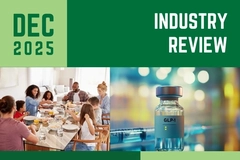
- Industry news
Industry news
Trending now
- Category news
- Reports
Trending now
- Key trends
Trending now
- Multimedia
Multimedia
Trending now
- Journal
- Events
Trending now
- Suppliers
Suppliers
Trending now
- Home
- Industry news
Industry news
Trending now
- Category news
- Reports
Trending now
- Key trends
Trending now
- Multimedia
Multimedia
Trending now
- Events
Trending now
- Suppliers
Suppliers
Trending now
World leaders rally to raise aid funds as USAID withdraws
The 63-year-old US Agency for International Development (USAID) has lost its independence, putting millions of lives at risk. At the same time, business leaders and officials are meeting in Seville, Spain, for the Fourth International Conference on Financing for Development (FFD4) to raise life-saving funding. Nutrition Insight looks at the impacts of the aid shutdown with Action Against Hunger and nutrition paste manufacturer Edesia.
Denish Ogen Rwot, South Sudan communication and advocacy lead at the humanitarian organization, states that USAID funding shortages are causing nutrition clinics to close, leading to community confusion and uncertainty. A lack of ready-to-use therapeutic food (RUTF) could mean death for malnourished children.
He says that many communities still don’t understand the full significance of the USAID shutdown after having seen their nutrition treatment clinics close.
“They still see USAID-branded T-shirts, signage, and supplies like oil gallons and WASH (water, sanitation, and hygiene) kits. The USAID logo has become a household brand for them. They still have hope in the US as their ‘big brother,’ who has stood with communities in South Sudan for years. It will take time for this reality to sink in.”
He adds that currently, team capabilities are insufficient to respond to emergencies, and a lack of supplies remains a challenge.
USAID’s operations, 90% of which are terminated, are being transferred to the US State Department, leading to US$1.4 billion in cuts in emergency nutrition funding, warns Action Against Hunger. RUTF is running critically low, with its nutrition experts predicting “mass loss of children’s lives.”
A new study, published in The Lancet, has found that USAID may cause 14 million additional deaths by 2030.
During a USAID farewell videoconference, former US presidents Barack Obama and George W. Bush criticized the Trump administration’s decision to dismantle USAID. Obama called it a “colossal mistake.”
Affected populations left confused
Action Against Hunger says that the funding cuts are affecting US peanut and dairy farmers, who supply the ingredients for the life-saving RUTF pouches. According to Rwot, RUTF stocks are “where the rubber meets the road.”
 According to Rwot, when shipments halt and families in his care ask his teams about supplies, they have no answers (Image credit: Nicolas Ossard).“For a malnourished child in our nutrition sites, this could mean death. For staff looking at parents coming in with nothing to support them, it creates confusion and uncertainty. Nutrition is 70–80% of our programming.”
According to Rwot, when shipments halt and families in his care ask his teams about supplies, they have no answers (Image credit: Nicolas Ossard).“For a malnourished child in our nutrition sites, this could mean death. For staff looking at parents coming in with nothing to support them, it creates confusion and uncertainty. Nutrition is 70–80% of our programming.”
“We first save lives, then create resilience, but how do we save lives when we don’t have the medicine (RUTF)? The problem is sweeping across all humanitarian aid organizations in South Sudan. For these children, it’s a matter of life and death,” he states.
According to Rwot, when shipments halt and families in his care ask his teams about supplies, they have no answers.
“How do you explain, after 30 years of good service, that there are no supplies? It’s a tricky place to be, and there won’t be satisfying answers for patients. It’s difficult for us to understand, let alone explain to the mothers whose children will soon die as a result.”
In February, Action Against Hunger told us how the USAID funding freeze forced it to halt life-saving operations in Haiti, Ethiopia, Nigeria, Madagascar, and Afghanistan, among many others. Save the Children spoke to Nutrition Insight in detail about its forced closures of 121 nutrition centers due to funding loss.
RUTF manufacturer remains optimistic
Navyn Salem, CEO of Edesia, manufactures Plumpy’Nut, a peanut-soy paste with milk powder, sugar, vitamins, and minerals, produced weekly to help treat and prevent malnutrition in 65 countries. Ninety percent of people on RUTF recover within two to three months.
Salem believes that the America First position comes naturally with RUTF manufacturing, and that this is why it has not been cancelled (Image credit: Abel Gichuru).She tells us that the US government has not explicitly decided to scale back on RUTF. “In the early days of the foreign assistance freeze, nearly every program was put on pause as they looked for examples of waste, fraud and abuse. Fortunately, the concept of emergency food assistance and RUTF was put on the list of programs we should continue.”
“Fortunately, this issue has risen to the surface as something that’s strategically important for the US government to maintain. I am remaining optimistic while we are in the midst of repairing the supply chain.”
Salem believes that the Trump administration supports nutritional products and programs despite terminating USAID. She argues that opportunities may arise when USAID comes under state control. “Yes, the system has been massively interrupted, and it will take us quite a while to catch up on six months of inactivity, but it’s my belief that support is there and will be back soon.”
“The other reality is that we have an America First position that just came naturally with RUTF manufacturing. We use American farmers, we are an American manufacturer, and we utilize American shippers. The concept of taking things that are purely American and turning them into goodwill is the reason that I believe RUTF hasn’t been cancelled.”
She adds: “Have we had any new orders? No. The State Department takes over for USAID today, and they will have the opportunity to turn all of this back on.”
Message to US decision-makers
Rwot urges US decision-makers to consider malnourished children and women who only get water at Action Against Hunger’s facilities. They come after walking for days and are traumatized from war. “Decision-makers should see that these are people: a mother, a child.”
 At the International Business Forum, businesses are meeting with officials to discuss finance and investment solutions (Image credit: FFD4).“Our treatment works. It saves their lives, but now, we’re running out of medication. For some, it’s even mid-treatment, like not finishing a prescription. Thousands of children need this support.”
At the International Business Forum, businesses are meeting with officials to discuss finance and investment solutions (Image credit: FFD4).“Our treatment works. It saves their lives, but now, we’re running out of medication. For some, it’s even mid-treatment, like not finishing a prescription. Thousands of children need this support.”
Lastly, Rwot is worried about the rollback effects of the rollback of peace-building progress, as communities had found better ways to work together. “If we revert, crises will restart and escalate with increased conflicts. In a worst-case scenario when funding reductions are absolutely required, I wish decision-makers would phase out funding gradually rather than abrupt cuts, so partners and communities can prepare.”
“But this abrupt cut means everything stops, and progress is just undone. Even beyond the children we treat, so many staff have lost their jobs in a country with no social security or unemployment benefits — they were working on the bare minimum, hand-to-mouth, and now return to communities defeated as former breadwinners,” he underscores.
Private and government finance push
As the largest global aid donor pulls away from foreign aid, nations at the FFD4 (30 June–3 July) renew the global framework for financing development. The event seeks to close the US$4 trillion financing gap for the Sustainable Development Goals (SDGs), resolve the debt crisis, and make the international financial system fairer and more transparent. Only 17% of the SDGs are on track.
An FAO economist recently spoke to Nutrition Insight about nutrition’s invisibility within the global finance architecture while offering solutions to overcome this. He also flagged that the system reinforces inequality by opting for inaction over innovation.
Li Junhua, UN under-secretary-general for Economic and Social Affairs and for the FFD4, believes the conference is a launchpad for a new era of action, accountability, and solidarity. “FFD4 offers us a once-in-a-decade opportunity to shift the tide.”
A key focus of the event is on the private sector’s role at the International Business Forum. Business leaders are meeting with government officials to discuss finance and investment solutions for sustainable development.
“Development is everyone’s business. And the private sector is an essential partner in helping countries climb the development ladder,” concludes António Guterres, secretary-general of the UN.











